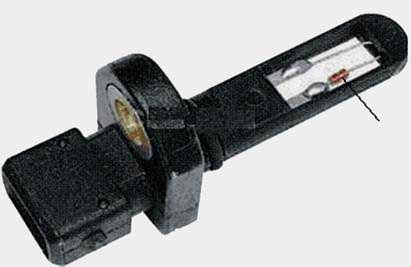Function and Typical Fault Analysis of Automotive Temperature Sensor
The temperature sensors on the car are mostly negative temperature coefficient thermistors. Such as the engine's intake air temperature sensor, coolant temperature sensor, oil temperature sensor, automatic transmission and oil temperature sensor of the continuously variable transmission. The dual clutch transmission is responsible for monitoring the G93 transmission oil temperature sensor of the transmission oil sump oil temperature and the G509 temperature sensor responsible for monitoring the working oil temperature of the transmission clutch. The indoor temperature sensor, the ambient temperature sensor, the evaporator temperature sensor, the suspension air pump temperature sensor, etc. of the air conditioner are all negative temperature coefficient thermistors. It is characterized by the higher the temperature of the measuring point, the lower the resistance value of the sensor, and the lower the output voltage signal. Taking the Mazda intake air temperature sensor as an example, when the ambient temperature is -20 ° C, 20 ° C, and 60 ° C, the resistance values are 13.6 to 18.4 kΩ, 2.21 to 2.69 kΩ, and 0.493 to 0.6967 kΩ, respectively.
The common fault of the negative temperature coefficient thermistor sensor is that the signal is abnormal, the sensor or the harness is short-circuited, and the data stream will have a false high temperature signal;
Sensor or harness disconnection, terminal water inlet or ground wire contact is poor, and the data stream will have a false low temperature signal. In addition, the control unit A/D converter is converted incorrectly, and a false high temperature signal may appear in the data stream.
First, the intake air temperature sensor
1. Intake air temperature sensor function
Except for the Karman vortex air flow sensor, the other engines are equipped with an intake air temperature sensor, as shown in Figure 1. The intake air temperature sensor can be installed in the air flow sensor or the intake pressure sensor, or it can be installed in a certain part of the intake port. When the engine intake temperature is high, the control unit will reduce the injection pulse width, and vice versa.

Figure 1 intake air temperature sensor
2. Intake air temperature sensor failure analysis
The intake air temperature sensor has poor contact with the ground wire, the data flow will show abnormally low temperature, and the low temperature air density will increase the injection pulse width, causing the mixed steam to be too rich. If the sensor is short-circuited, the data flow will show abnormally high temperature, and the high-temperature air density will be low, which will reduce the fuel injection pulse width and cause the mixed steam to be too thin. The higher the temperature of the intake air temperature sensor, the thicker the mixture, and the open circuit or poor grounding of the sensor may cause the mixed steam to be too thin, resulting in difficulty in starting.
The common fault of the negative temperature coefficient thermistor sensor is that the signal is abnormal, the sensor or the harness is short-circuited, and the data stream will have a false high temperature signal;
Sensor or harness disconnection, terminal water inlet or ground wire contact is poor, and the data stream will have a false low temperature signal. In addition, the control unit A/D converter is converted incorrectly, and a false high temperature signal may appear in the data stream.
First, the intake air temperature sensor
1. Intake air temperature sensor function
Except for the Karman vortex air flow sensor, the other engines are equipped with an intake air temperature sensor, as shown in Figure 1. The intake air temperature sensor can be installed in the air flow sensor or the intake pressure sensor, or it can be installed in a certain part of the intake port. When the engine intake temperature is high, the control unit will reduce the injection pulse width, and vice versa.

Figure 1 intake air temperature sensor
2. Intake air temperature sensor failure analysis
The intake air temperature sensor has poor contact with the ground wire, the data flow will show abnormally low temperature, and the low temperature air density will increase the injection pulse width, causing the mixed steam to be too rich. If the sensor is short-circuited, the data flow will show abnormally high temperature, and the high-temperature air density will be low, which will reduce the fuel injection pulse width and cause the mixed steam to be too thin. The higher the temperature of the intake air temperature sensor, the thicker the mixture, and the open circuit or poor grounding of the sensor may cause the mixed steam to be too thin, resulting in difficulty in starting.





